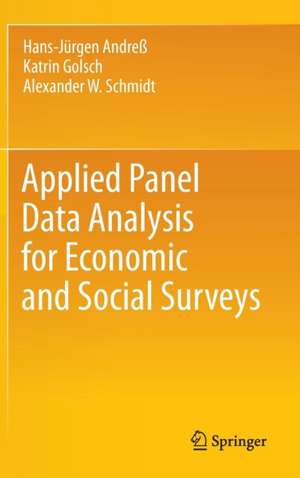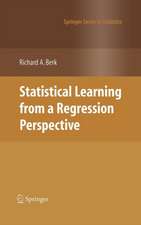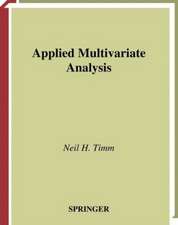Applied Panel Data Analysis for Economic and Social Surveys
Autor Hans-Jürgen Andreß, Katrin Golsch, Alexander W. Schmidten Limba Engleză Hardback – 25 ian 2013
| Toate formatele și edițiile | Preț | Express |
|---|---|---|
| Paperback (1) | 586.23 lei 6-8 săpt. | |
| Springer Berlin, Heidelberg – iul 2015 | 586.23 lei 6-8 săpt. | |
| Hardback (1) | 735.07 lei 6-8 săpt. | |
| Springer Berlin, Heidelberg – 25 ian 2013 | 735.07 lei 6-8 săpt. |
Preț: 735.07 lei
Preț vechi: 896.43 lei
-18% Nou
Puncte Express: 1103
Preț estimativ în valută:
140.66€ • 147.23$ • 117.07£
140.66€ • 147.23$ • 117.07£
Carte tipărită la comandă
Livrare economică 31 martie-14 aprilie
Preluare comenzi: 021 569.72.76
Specificații
ISBN-13: 9783642329135
ISBN-10: 3642329136
Pagini: 344
Ilustrații: XV, 327 p.
Dimensiuni: 155 x 235 x 24 mm
Greutate: 0.66 kg
Ediția:2013
Editura: Springer Berlin, Heidelberg
Colecția Springer
Locul publicării:Berlin, Heidelberg, Germany
ISBN-10: 3642329136
Pagini: 344
Ilustrații: XV, 327 p.
Dimensiuni: 155 x 235 x 24 mm
Greutate: 0.66 kg
Ediția:2013
Editura: Springer Berlin, Heidelberg
Colecția Springer
Locul publicării:Berlin, Heidelberg, Germany
Public țintă
GraduateCuprins
Introduction: Benefits and challenges of the panel design.- Outline of the book.- Audience and prerequisites.- Acknowledgements.- Managing panel data: The nature of panel data.- The basics of panel data management.- Three case studies on poverty in Germany.- How to represent a population with panel data?- Conclusion and further reading.- Describing and modeling panel data: Some basic terminology.- Measurements over time are not independent.- Describing the dependent variable.- Explaining the dependent variable over time: typical explanatory variables.- Modeling panel data.- Estimating models for panel data.- Overview of subsequent chapters.- Panel analysis of continuous variables: Modeling the level of Y.- Modeling the change of Y.- Conclusion and further reading.- Panel analysis of categorical variables: Modeling the level of Y: Discrete response models for panel data.- Modeling the change of Y: Discrete-time event history models for panel data.- Conclusion and further reading.- Conclusion: How to do your own panel analysis.- A: Functions of random variables.- B: Estimation and testing: Ordinary least squares.- How to compute a regression model fitting the data?- Sampling and sampling errors.- How to choose between different estimation methods?- How to estimate the parameters of an unknown population with a sample of data?- How to test parameters of an unknown population with a sample of data?- Maximum likelihood .- C: Web site of the textbook.- Bibliography.- Index.
Recenzii
“The monograph considers contemporary statistical analysis of panel survey data with repeated in time measurements on identical individuals, households, firms, nations, or other social entities. … The monograph presents an excellent introductory textbook on the panel data … . The book can be very helpful for lecturers, graduate students, and researchers using panel survey methods.” (Stan Lipovetsky, Technometrics, Vol. 59 (1), February, 2017)
“This book is written for applied researchers in the social fields. The level of the book refers to users with some theoretical background in statistics and econometrics, but no sound knowledge is required to read the book.” (Herbert S. Buscher, zbMATH, Vol. 1276, 2014)
“This book is written for applied researchers in the social fields. The level of the book refers to users with some theoretical background in statistics and econometrics, but no sound knowledge is required to read the book.” (Herbert S. Buscher, zbMATH, Vol. 1276, 2014)
Notă biografică
Hans-Jürgen Andreß a is Full Professor in Empirical Social and Economic Research at the Faculty of Business Administration, Economics and Social Sciences at the University of Cologne. His research interests include statistics and multivariate methods; labor market research; social and family policy.
Katrin Golsch is a senior researcher at the Department of Sociology at Bielefeld University, Germany. Her core interests include statistical methods for the analysis of survey data and longitudinal data analysis in particular, life-course analysis, social structure, labor market research and comparative sociological research.
Alexander Schmidt is a PhD candidate at the Research Training Group SOCLIFE, funded by the Germany Science Foundation. He teaches computer assisted data analysis and survey research at the Chair of Empirical Social and Economic Research at the Faculty of Business Administration, Economics and Social Sciences at the University of Cologne. His research focuses on social mobility and comparative welfare state analysis.
Katrin Golsch is a senior researcher at the Department of Sociology at Bielefeld University, Germany. Her core interests include statistical methods for the analysis of survey data and longitudinal data analysis in particular, life-course analysis, social structure, labor market research and comparative sociological research.
Alexander Schmidt is a PhD candidate at the Research Training Group SOCLIFE, funded by the Germany Science Foundation. He teaches computer assisted data analysis and survey research at the Chair of Empirical Social and Economic Research at the Faculty of Business Administration, Economics and Social Sciences at the University of Cologne. His research focuses on social mobility and comparative welfare state analysis.
Textul de pe ultima copertă
Many economic and social surveys are designed as panel studies, which provide important data for describing social changes and testing causal relations between social phenomena. This textbook shows how to manage, describe, and model these kinds of data. It presents models for continuous and categorical dependent variables, focusing either on the level of these variables at different points in time or on their change over time. It covers fixed and random effects models, models for change scores and event history models. All statistical methods are explained in an application-centered style using research examples from scholarly journals, which can be replicated by the reader through data provided on the accompanying website. As all models are compared to each other, it provides valuable assistance with choosing the right model in applied research. The textbook is directed at master and doctoral students as well as applied researchers in the social sciences, psychology, business administration and economics. Readers should be familiar with linear regression and have a good understanding of ordinary least squares estimation.
Caracteristici
Easy accessible: introduces into main methods of panel data analysis without expecting specialized mathematical and statistical knowledge Replicates research from major social science journals to explain methods For all students and researchers using household panel studies like GSOEP, BHPS, or PSID Includes supplementary material: sn.pub/extras













